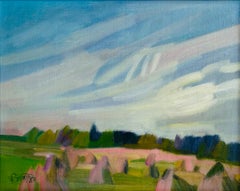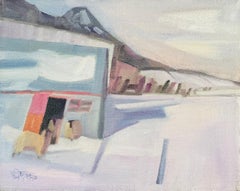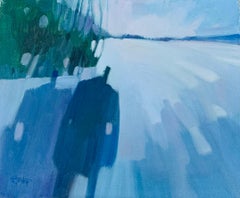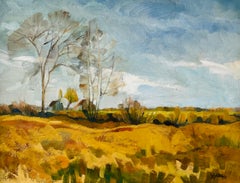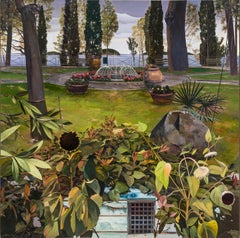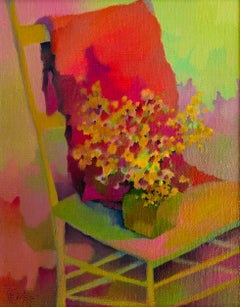Claude Le Sauteur Art
to
3
6
6
Overall Height
to
Overall Width
to
5
5
3
2
2
1
1
1
1
6
1
5
6
6,958
3,331
2,514
1,213
6
6
Artist: Claude Le Sauteur
Gerbes sous le soleil
By Claude Le Sauteur
Located in Westmount, QC
Claude Le Sauteur, Canadian, 1926-2007
GERBES SOUS LE SOLEIL, 1980
Oil on canvas
8 x 10 in
signed and dated on lower left Le Sauteur 80;
Signed, dated and titled verso;
Kastel Galler...
Category
1980s Claude Le Sauteur Art
Materials
Oil
Coteaux vêtus d'ocre
By Claude Le Sauteur
Located in Westmount, QC
Claude Le Sauteur, Canadian, 1926-2007
Coteaux vêtus d'ocre, 1979
Oil on canvas
10 x 12 in
Signed and dated lower right;
signed, dated, and titled verso
Category
1980s Claude Le Sauteur Art
Materials
Oil
The lambs
By Claude Le Sauteur
Located in Westmount, QC
Claude Le Sauteur, Canadian, 1926-2007
The lambs, 1980
Oil on canvas
8 x 10 in
Signed and dated lower left;
signed and titled verso
framed
Category
1980s Claude Le Sauteur Art
Materials
Oil
Les ombres (The shadows)
By Claude Le Sauteur
Located in Westmount, QC
Claude Le Sauteur, Canadian, 1926-2007
LES OMBRES (THE SHADOWS)
Oil on canvas
10 x 12 in
Signed and dated lower left; signed and titled verso
framed
Category
1980s Claude Le Sauteur Art
Materials
Oil
untitled
By Claude Le Sauteur
Located in Westmount, QC
Claude Le Sauteur
1926-2007
Oil on canvas
12 x 16 in
Category
1970s Claude Le Sauteur Art
Materials
Oil
Fields
By Claude Le Sauteur
Located in Westmount, QC
Claude Le Sauteur, Canadian, 1926-2007
1975
Oil on canvas
14 x 18 in
signed and dated on lower right Le Sauteur 75
framed
Category
1980s Claude Le Sauteur Art
Materials
Oil
Related Items
"A Reverie During The Ball", 19th Century Oil on Canvas by Rogelio Egusquiza
By Rogelio de Egusquiza y Barrena
Located in Madrid, ES
ROGELIO DE EGUSQUIZA
Spanish, 1845 - 1915
A REVERIE DURING THE BALL
signed and dated "Rogelio Egusquiza, 1879" (lower right)
oil on canvas
21-3/4 X 3...
Category
1870s Symbolist Claude Le Sauteur Art
Materials
Canvas, Oil
Italian Garden in Acadia
By John Moore
Located in New York, NY
Signed (at lower right): MOORE
Category
2010s Contemporary Claude Le Sauteur Art
Materials
Oil
18th century oil sketches for a Baroque interior - a pair
Located in London, GB
A FEAST OF THE GODS WITH VENUS AND BACCHUS
Collections:
With Appleby Brothers, London, June 1957;
Hazlitt, Gooden & Fox, London, 1961;
John and Eileen Harris, acquired from the above, to 2015.
Literature:
Jacob Simon and Ellis Hillman, English Baroque Sketches: The Painted Interior in the Age of Thornhill, 1974, cat. no.12 (as by Louis Laguerre);
Elizabeth Einberg (ed.), Manners and Morals: Hogarth and British Painting, 1700-1760, exh. cat., London (Tate Gallery), 1987, cat. no.10 (as by Louis Laguerre);
Tabitha Barber and Tim Bachelor, British Baroque: Power and Illusion, exh. cat., London (Tate Britain), 2020.
Exhibited:
Twickenham, Marble Hill House, English Baroque Sketches: The Painted Interior in the Age of Thornhill, 1974, no.12 (as by Louis Laguerre);
London, Tate Gallery, Manners and Morals: Hogarth and British Painting, 1700-1760, 1987, no.10 (as by Louis Laguerre);
London, Tate Britain, British Baroque: Power and Illusion, cat. no 92, 2020.
CUPID AND PSYCHE BEFORE JUPITER
Collections:
With Appleby Brothers, London, June 1957;
Hazlitt, Gooden & Fox, London, 1961;
Anthony Hobson, acquired from the above, to 2015.
These recently re-united paintings are the most ambitious surviving baroque ceiling sketches made in Britain in the early eighteenth century. From the Restoration until the rise of Palladianism in the 1720s decorative history painting formed the preeminent artistic discipline in Britain. It was a field dominated by Continental artists including the Italian Antonio Verrio and the Frenchmen Louis Laguerre and Louis Chéron...
Category
Early 18th Century Baroque Claude Le Sauteur Art
Materials
Oil, Canvas
The Harvest
Located in London, GB
Farmhands working in a field on a hot summer's day.
Building on iconic depictions of farmworkers by Millet, Huys sought to imbue his figures with a sensitivity and reverence that ...
Category
20th Century Claude Le Sauteur Art
Materials
Canvas, Oil
"Sunday in the Park, 1910"
By Cyprien Eugène Boulet
Located in Lambertville, NJ
Signed Lower Right
Cyprien-Eugène Boulet (1877 - 1927)
Category
Early 20th Century Impressionist Claude Le Sauteur Art
Materials
Canvas, Oil
A Trail through the Trees
By Albert Bierstadt, 1830-1902
Located in New York, NY
Monogrammed lower left: ABierstadt
Category
19th Century Hudson River School Claude Le Sauteur Art
Materials
Board, Oil
Giovanni Battista Pittoni, Holy Family with Cupids, Venetian Baroque, Christmas
By Giovanni Battista Pittoni
Located in Greven, DE
In 2001 the German art historian Art historian and Raphael Expert, Prof. Jürg Meyer zur Capellen, published the painting "Die Heilige Familie" in a monographic article, ascribing the present work to the Venetian painter Giovanni Battista Pittoni (1687 -Venice - 1767). (Newspaper "Weltkunst", October 2001, No 12, p. 1850 f. ill.)
He describes it as a typical work by this artist. Pittoni was one of the most influential and successful artists of the Venetian Settecento. He was a pupil of the Veronese Master Giovanni Balestra (1666-1740). His style is influenced by Sebastiano Ricci (1659-1734) and Giambattista Tiepolo (1696-1770).
Giovanni Battista Pittoni was already successful at a young age and soon lead his own workshop.
He created large-scale hitoria paintings, as well as large, religious altarpieces. In addition to Venetian and Upper Italian patrons, Pittoni also had many interested parties from Europe. His work is accordingly scattered in many different museums and private collections today. Pittoni - like other painter colleagues of his time - repeated his own compositions both by hand and with the help of his workshop. He repeatedly incorporated details into other pictures and contexts.
Prof. Meyer zur Capellen noted the very good condition of the present work and the high quality of the paint with fine graduations and the vivid brushstrokes.
Provenance: The panting has not been on the art market for at least 300 years. In the year 2000 the work was donated by the Münster-based, Noble Family Ketteler zu Harkotten to a private collection in Westphalia. Most probably the canon Nikolaus Hermann von Ketteler zu Harkotten bought the piece in Venice in 1750 together with the altarpiece of the Clemens Church in Münster.
On the reverse of the work is a fideicommissum number by Ketteler zu Harkotten.
As it belonged to the family commission, the painting was inalienable until 1919, when the corresponding law was repealed, and after that time it remained in the family's possession without interruption. Pittoni's only direct relationship to Münster is the commission for the high altar painting of the Baroque St. Clemens Church. It can be assumed that then canon von Ketteler saw this painting in the artist's workshop during his stay in Venice and acquired it for himself. This would also explain the discrepancy in dating. (ca. 1735/1750). However, it is also possible that the painting originated in the possession of Ferdinand von Plettenberg...
Category
Early 18th Century Rococo Claude Le Sauteur Art
Materials
Canvas, Oil
San Pedro Harbor
By Paul Sample
Located in New York, NY
It is infrequent, to say the least, that a diagnosis of tuberculosis proves fortuitous, but that was the event, in 1921, that set Paul Starrett Sample on the road to becoming a professional artist. (The best source for an overview of Sample’s life and oeuvre remains Paul Sample: Painter of the American Scene, exhib. cat., [Hanover, New Hampshire: Hood Museum of Art, 1988] with a detailed and definitive chronology by Sample scholar, Paula F. Glick, and an essay by Robert L. McGrath. It is the source for this essay unless otherwise indicated.) Sample, born in Louisville, Kentucky, in 1896 to a construction engineer and his wife, spent his childhood moving with his family to the various locations that his father’s work took them. By 1911, the family had landed in Glencoe, Illinois, settling long enough for Paul to graduate from New Trier High School in 1916. Sample enrolled at Dartmouth College, in Hanover, New Hampshire, where his interests were anything but academic. His enthusiasms included the football and basketball teams, boxing, pledging at a fraternity, and learning to play the saxophone. After the United States entered World War I, Sample, to his family’s dismay, signed on for the Naval Reserve, leading directly to a hiatus from Dartmouth. In 1918 and 1919, Sample served in the U.S. Merchant Marine where he earned a third mate’s license and seriously contemplated life as a sailor. Acceding to parental pressure, he returned to Dartmouth, graduating in 1921. Sample’s undergraduate life revolved around sports and a jazz band he formed with his brother, Donald, two years younger and also a Dartmouth student. In November 1933, Sample summarized his life in a letter he wrote introducing himself to Frederick Newlin Price, founder of Ferargil Galleries, who would become his New York art dealer. The artist characterized his undergraduate years as spent “wasting my time intensively.” He told Price that that “I took an art appreciation course and slept thru it every day” (Ferargil Galleries Records, circa 1900–63, Archives of American Art, Smithsonian Institution, available on line).
In 1920, Donald Sample contracted tuberculosis. He went for treatment to the world-famous Trudeau Sanitorium at Saranac Lake, in New York State’s Adirondack Mountains for the prescribed regimen of rest, healthful food, and fresh air. Visiting his brother in 1921, Paul also contracted the disease. Tuberculosis is highly contagious, and had no certain cure before the development of streptomycin in 1946. Even for patients who appeared to have recovered, there was a significant rate of recurrence. Thus, in his letter to Price, Sample avoided the stigma conjured by naming the disease, but wrote “I had a relapse with a bad lung and spent the next four years hospitalized in Saranac Lake.” The stringent physical restrictions imposed by adherence to “the cure” required Sample to cultivate an alternate set of interests. He read voraciously and, at the suggestion of his physician, contacted the husband of a fellow patient for instruction in art. That artist, then living in Saranac, was Jonas Lie (1880–1940), a prominent Norwegian-American painter and an associate academician at the National Academy of Design. Lie had gained renown for his dramatic 1913 series of paintings documenting the construction of the Panama Canal (The Metropolitan Museum of Art, New York; United States Military Academy, West Point, New York). Primarily a landscape artist, Lie had a particular affinity for scenes with water. His paintings, impressionistic, atmospheric, and brushy, never strayed from a realistic rendering of his subject. Sample regarded Lie as a mentor and retained a lifelong reverence for his teacher. Sample’s early paintings very much reflect Lie’s influence.
`
In 1925, “cured,” Sample left Saranac Lake for what proved to be a brief stay in New York City, where his veteran’s benefits financed a commercial art course. The family, however, had moved to California, in the futile hope that the climate would benefit Donald. Sample joined them and after Donald’s death, remained in California, taking classes at the Otis Art Institute in Los Angeles. In Sample’s account to Price, “I couldn’t stomach the practice of painting a lot of High Sierras and desert flowers which seemed to be the only kind of pictures that were sold here so I got a job teaching drawing and painting at the art school of the University of Southern California.” Initially hired as a part-time instructor, Sample progressed to full-time status and ultimately, by the mid-1930s, to the post of Chairman of the Fine Art Department. Sample, however, did not want to wind up as a professor. “Teaching is all right in small doses,” he wrote, “but I have a horror of drifting into being a college professor and nothing more.” At the same time as he taught, Sample began to exhibit his work in a variety of venues at first locally, then nationally. Though he confessed himself “a terrible salesman,” and though occupied with continued learning and teaching, Sample was nonetheless, ambitious. In 1927, he wrote in his diary, “I am eventually going to be a painter and a damned good one. And what is more, I am going to make money at it” (as quoted by Glick, p. 15). In 1928, Sample felt sufficiently solvent to marry his long-time love, Sylvia Howland, who had also been a patient at Saranac Lake. The Howland family were rooted New Englanders and in summertime the Samples regularly traveled East for family reunion vacations.
While the 1930s brought serious hardship to many artists, for Paul Sample it was a decade of success. Buttressed by the financial safety net of his teacher’s salary, he painted realist depictions of the American scene. While his work addressed depression-era conditions with a sympathetic eye, Sample avoided the anger and tinge of bitterness that characterized much contemporary realist art. Beginning in 1930, Sample began to exhibit regularly in juried exhibitions at important national venues, garnering prizes along the way. In 1930, Inner Harbor won an honorable mention in the Annual Exhibition of the Art Institute of Chicago. That same year Sample was also represented in a show at the Albright-Knox Gallery in Buffalo and at the Biennial Exhibition of the Corcoran Gallery of Art, Washington, D.C. In 1931, Dairy Ranch won the second Hallgarten Prize at the Annual Exhibition of the National Academy of Design, in New York. Sample also made his first appearances at the Carnegie Institute, Pittsburgh, and The Pennsylvania Academy of the Fine Arts, Philadelphia. In 1936, Miner’s Resting won the Temple Gold Medal at the Pennsylvania Academy’s Annual Exhibition. Always interested in watercolor, in 1936, Sample began to send works on paper to exhibitions at the Whitney Museum, New York.
While participating in juried exhibitions, Sample also cultivated commercial possibilities. His first New York art dealer was the prestigious Macbeth Gallery in New York, which included his work in a November 1931 exhibition. In 1934, Sample joined the Ferargil Galleries in New York, after Fred Price arranged the sale of Sample’s Church Supper to the Michele and Donald D’Amour Museum of Fine Arts in Springfield, Massachusetts. In 1937, The Metropolitan Museum of Art purchased Sample’s Janitor’s Holiday from the annual exhibition of the National Academy of Design, a notable honor.
As prestigious as this exhibition schedule may have been, by far Sample’s most visible presence in the 1930s and 1940s was the result of his relationship with Henry Luce’s burgeoning publishing empire, Time, Inc. Sample’s first contribution to a Luce publication appears to have been another San Pedro...
Category
20th Century American Modern Claude Le Sauteur Art
Materials
Canvas, Oil
HOMAGE TO THE CLASSICS
By Ferjo, Fernando de Jesus Oliveira
Located in Aventura, FL
Original oil painting on canvas. Hand signed on front by the artist. Canvas is stretched.
Artwork is in excellent condition. Certificate of authenticity included. All reasonable...
Category
21st Century and Contemporary Surrealist Claude Le Sauteur Art
Materials
Canvas, Oil
The Grape Seller by Jacob Ochtervelt (Workshop), Oil on Canvas, Period Frame
Located in Stockholm, SE
Jacob Ochtervelt (Workshop)
The Grape Seller
There are two known versions of this subject.
This is a reduced variant of Ochtervelt's signed and dat...
Category
1660s Dutch School Claude Le Sauteur Art
Materials
Canvas, Oil
Free Shipping
H 43.12 in W 35.04 in
"Mountain Labyrinths"
By John F. Carlson
Located in Lambertville, NJ
Ashley John is proud to offer this artwork by:
John Fabian Carlson (1874/75 - 1945)
John F. Carlson was one of the leading American landscape p...
Category
Early 20th Century Tonalist Claude Le Sauteur Art
Materials
Canvas, Oil
'Agay, le château et le Sémaphore'. Oil on canvas. Signed.
By Armand Guillaumin
Located in Paris, FR
'Agay, le château et le Sémaphore'.
Oil on canvas. +/- 1922
Signed lower right
Measurements : 60 x 73 cm.
This painting will be recorded in the second volume of the Catalogue Raisonn...
Category
1920s Impressionist Claude Le Sauteur Art
Materials
Oil
H 23.63 in W 28.75 in
Previously Available Items
Fleurs des champs
By Claude Le Sauteur
Located in Westmount, QC
Claude Le Sauteur, Canadian, 1926-2007
Fleurs des champs
Oil on canvas
12 x 10 in
Signed lower left; signed and titled verso;
PROVENANCE
Galerie d’ar...
Category
1980s Claude Le Sauteur Art
Materials
Oil
Claude Le Sauteur art for sale on 1stDibs.
Find a wide variety of authentic Claude Le Sauteur art available for sale on 1stDibs. If you’re browsing the collection of art to introduce a pop of color in a neutral corner of your living room or bedroom, you can find work that includes elements of blue and other colors. You can also browse by medium to find art by Claude Le Sauteur in oil paint, paint and more. Not every interior allows for large Claude Le Sauteur art, so small editions measuring 10 inches across are available. Customers who are interested in this artist might also find the work of David Rosen (b.1912), Bruno Côté, and Natasha Miller. Claude Le Sauteur art prices can differ depending upon medium, time period and other attributes. On 1stDibs, the price for these items starts at $1,500 and tops out at $2,300, while the average work can sell for $1,875.
